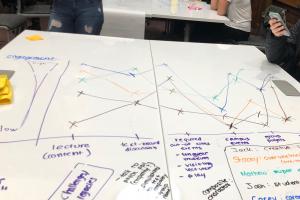
Strong communication relies on active listening.
A project-based seminar on Design Thinking challenged me to collaboratively employ an empirical, human-centered approach to reimagining Colgate’s Core Curriculum. I researched and analyzed my group's recommendation’s quantitative assumptions to ensure its operational feasibility. The project culminated in a well-received 10-minute presentation to an audience of peers, faculty, and administration, alongside a 14-page formal proposal.
The first step of the design process involved collecting qualitative data through dozens of interviews to better empathize with our community. I walked into each with a written list of questions and a mental list of anticipated responses, yet was consistently met with shock. Interviewing relies on listening without sharing– reflection revealed that I shaped conversation towards the familiar by identifying and focusing on shared values and experiences. Intent on creating a proposal relevant to the community, I attempted to instead approach interviews with curiosity and reflection. The distinct perspectives of students and faculty added critical depth to my portrait of the Core, empowering me to refine the team’s design problem.
Active listening is an invaluable skill. Not only does the form rely on treating others with empathy and respect, but it is also a low cost-high reward approach to conversation. Moreover, an open mind is a strong tool against unconscious bias. Interviews revealed that students and faculty were experiencing the same classes with distinct lenses, consistent with neither majors nor backgrounds. I could not presume to grasp how someone experienced their classes because people are fundamentally defined by their distinctive mindsets.
I immediately utilized this skill to improve my interactions with the team. The effort prompted greater collaboration and creativity, and we soon landed on our final solution of team-teaching. Active listening also allowed me to identify my relative quantitative strength on the team. When an administrator noted logistical concerns, I took the initiative to recalculate the distribution of Core professors to demonstrate the feasibility of the proposal. Such is the value of specialization and synergy.
The experiential project-based style of learning brought me a deep appreciation for collaborative learning and working environments. The class has been my favorite at Colgate.
UNST 350: The Core Edition, Hamilton, NY (Fall 2018): Approximately every ten years, Colgate embarks on a revision of the Core Curriculum, spearheaded by the Division of University Studies. That fall, the Division moved into the first phase of the process: a self-study. In a first-ever curriculum-based collaboration between students and faculty, my class was an integral component of that self-study. All of our findings, data, ideas, and proposals were presented to the University Studies University Professors. The UPs followed our progress and supported us throughout the course, invested in this innovative collaboration as a way to provide new perspectives and ideas.
EXCERPT: By introducing a variety of lenses, team teaching provides students with more complex understandings of unfamiliar systems of thought, resulting in greater capacities for empathizing with previously unfamiliar or unconventional information. Our proposal for various types of team-taught classes is predicated on two important observations:
- Team-taught classes engage students in interdisciplinary learning, allowing them to interact with unfamiliar content through a variety of perspectives and intellectual frameworks. It is essential to craft curricula that provide students with the space to take risks and, as a result, grow as learners. Professors and students alike benefit from the intellectual stimulation inherent in exploring concepts from multiple angles and structures. Emphasizing interdisciplinary methods through team teaching is a realistic approach to attain these goals.
- By identifying in team-taught courses how disciplines contribute to and come into conflict with one another, professors can model critical thinking skills effectively for students. For example, a student in a gender-economics team-taught course would not only learn about the impact of gender on economics, but also how to deconstruct the way philosophy or immigration principles affect economics. By applying interdisciplinary models, team-taught courses build the framework for complex and nuanced thinking. Learning to defend one’s opinions and assess varied sources of information are critical skills both in and beyond the classroom.
| Empathize | Conducted 20+ interviews with students, faculty, and administrators about how they derive value from Core classes |
| Define | How might we encourage students to self-reflect and, in so doing, to deconstruct different systems of thought? |
| Ideate | Increase the availability of team-teaching in the Core |
| Prototype | Developed circular diagrams to illustrate potential interdisciplinary courses that could be implemented in the Core |
| Test | Asked students to draw lines and connect subjects they believed would be interesting |